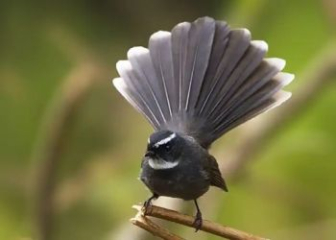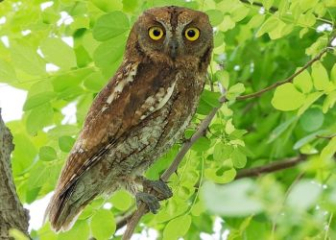Fiery Bulbul - Technique to raise Fiery Bulbul to sing the loudest
Blog | by
The Fiery Bulbul (Copsychus malabaricus) has a striking appearance with three colors: black, orange-red and white; its melodious song, sometimes low, sometimes high, is very pleasing to the ear.
The Fiery Bulbul is a pet bird that fascinates many people with its eye-catching appearance and melodious singing voice. They have shiny black feathers combined with a bright orange-red belly and a super long tail, creating a very majestic and powerful appearance. In addition, their singing voice is also very special because the sound is sometimes low, sometimes high.
So what is interesting about this bird and is it easy to raise and care for? Let 's nicebirds find out the details in the article below!
Information about the Red-whiskered Bulbul :
|
Scientific name |
Copsychus malabaricus |
|
Common name |
White-tailed bulbul, white-tailed bulbul |
|
Set |
Passeriformes - Sparrows |
|
Surname |
Muscicapidae - Flycatchers |
|
Source |
India, Southeast Asia |
|
Size |
Length 23 - 28 cm (including tail) Weight: 28 - 34 g |
|
Lifespan |
Origin of the Red-whiskered Bulbul
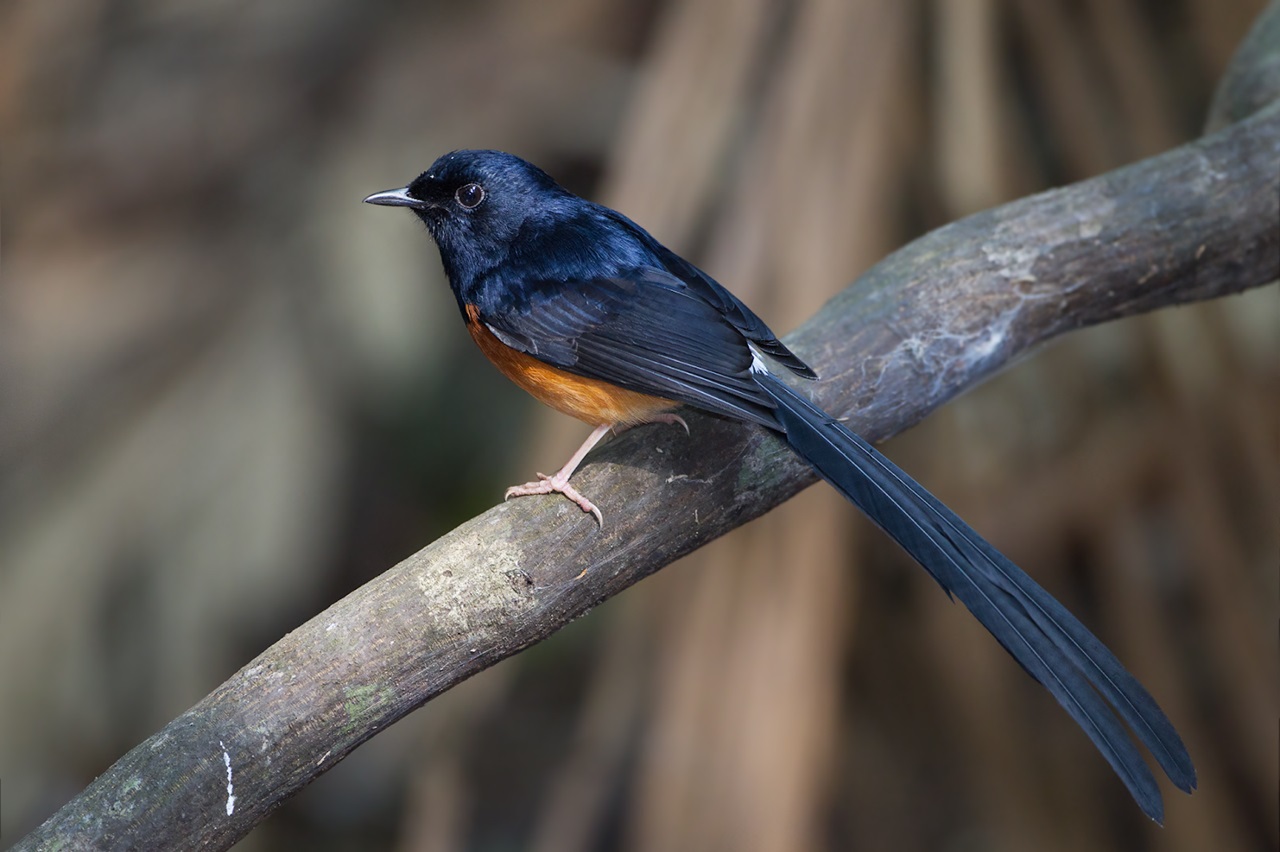
The red-whiskered bulbul is a bird native to South and Southeast Asia.
The Indian Magpie (scientific name Copsychus malabaricus) is a native bird of India and Southeast Asia, distributed in many countries as follows:
- India: Especially in the Malabar region.
- Vietnam
- Indonesia
- Laos
- Cambodia
- Myanmar
- Thailand
In Vietnam, the red-whiskered bulbul is distributed in tropical forests and low mountains in the southern, Central Highlands and central provinces.
Nowadays, thanks to its beautiful appearance and sweet voice, the red-whiskered bulbul is very popular and loved among pet birds in our country.
Appearance of the Red-whiskered Bulbul
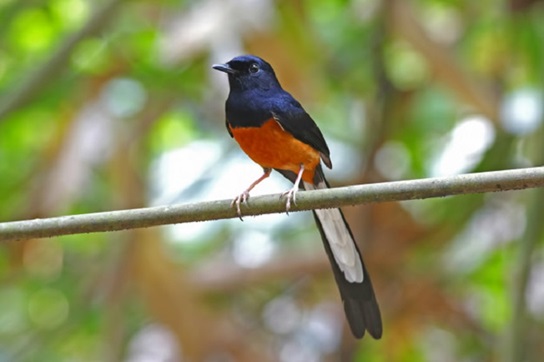
The colorful appearance of a red-whiskered bulbul.
In contrast to the monotony of the black-winged bulbul, the red-winged bulbul has an extremely striking, strong and attractive appearance thanks to its colorful colors and long, graceful tail. Let's find out more about the appearance of this bird below.
- Size : Length from 23 - 28 cm, of which the tail accounts for nearly half.
- Weight : About 23 - 28 g
- Color : The head and back are glossy black with a blue tint, the belly and chest are bright orange or fiery red - this is also the reason why this bird is called the fire-breasted shama.
- Wings : Black and combined with a long white stripe, most clearly visible when the bird spreads its wings.
- Tail : Very long, slightly curved, black in colour with white stripes on both sides.
- Eyes : Round, jet black, looks very smart.
- Legs : Light pink or slightly gray, small, strong.
Distinguishing between male and female red-whiskered bulbuls:
- Male Red-whiskered Bulbul: Dark plumage, bright red belly, longer tail, taller and sings more than female.
- Female Red-whiskered Bulbul: Lighter in color, orange-brown belly, small, round body and sings less than the male.
Habits of the Red-whiskered Bulbul
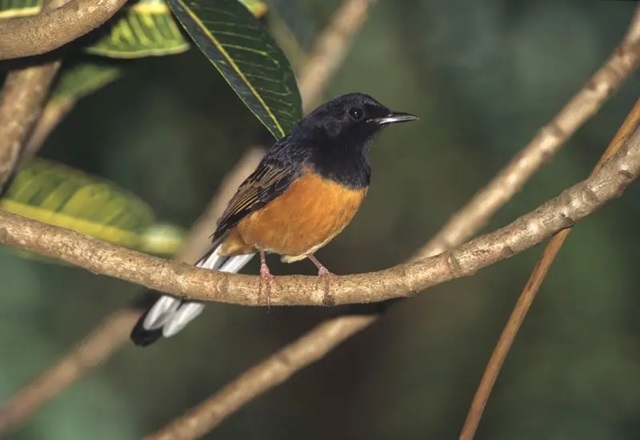
The shama loves to hop back and forth between the trees.
The red-whiskered bulbul not only has a striking appearance but also a unique temperament, a beautiful singing voice and is extremely “aggressive”. Details will be shared below, let’s find out more!
Active, like to dance
Like many other types of magpies, red magpies are very active. They like to jump and move between tree branches. They are usually active during the day and are especially active in the early morning or cool afternoon.
In addition, sunbirds also love to sunbathe and bathe in water. This action not only helps the birds have smooth feathers but also makes them healthier.
Use clear chirping to communicate
The Red-whiskered Bulbul has a clear, long-lasting song with many different melodies. Besides, they also have the ability to imitate the sounds of many different birds.
They also use songs to communicate with others, to express themselves, to attract mates, and even to mark territory.
Strongly territorial
The shama is also quite territorial, especially the male. When it detects any male approaching, it will start singing loudly or perform threatening behaviors to scare the other away. It may even puff up its pussy, flap its wings or make a more “angry” call than usual.
Only like to eat insects
Like the black-throated bulbul, the red-throated bulbul only likes to eat insects such as worms, crickets, grasshoppers, cockroaches, etc. They do not eat fruits or vegetables.
Techniques for raising Fire-breasted Bulbuls to sing well (fire-breasted)
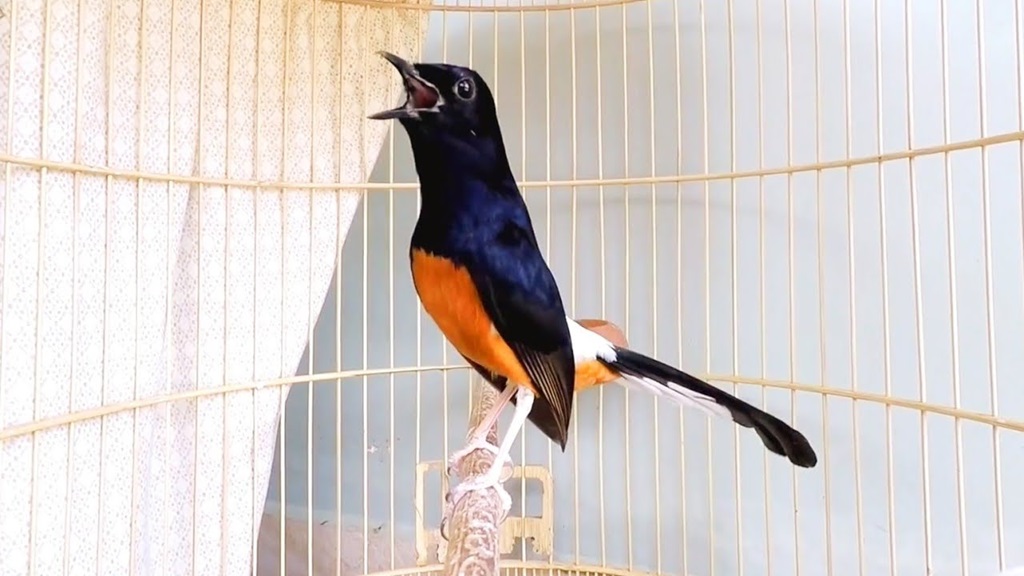
A red-whiskered bulbul is singing loudly.
Singing loudly, singing a lot and energetically is the best singing state of the red-whiskered bulbul. However, not everyone can reach this level because you need to harmoniously combine nutrition, care, training and the bird's living environment. If you want to learn more about this technique, don't miss the content shared below.
Choose good quality shama birds
First, to have a healthy, energetic bird that can sing loudly, you need to choose the best breeding bird. You need to note the following points:
- Prefer male birds because they sing better and more than female birds.
- Choose birds with straight posture, long tail, high tail, bright eyes, smooth feathers, tall legs.
- You should choose birds trapped from the forest because wild birds often sing better and more energetically than farmed birds.
Proper diet
One factor considered to be the most important in helping the red-whiskered bulbul sing well is its nutrition. You should feed your bird some of the following foods:
Main food :
- Special bran for red-whiskered bulbuls.
- Clean water should be provided in sufficient quantity and changed daily.
Food supplement :
The following foods are all very good for the process of stimulating and maintaining the fire in the firebird, but need to be fed in appropriate doses about 2 - 4 times per week.
- Small: Crickets provide protein, increase energy, and help birds sing with passion.
- Small earthworms: Should be fed to birds during molting to supplement nutrition.
- Rice worms: This is the food that stimulates birds to light fire and keep the fire going best.
- Fox scratch, grasshopper: Helps birds have shiny, smooth feathers.
- Ant eggs: A food that stimulates birds to sing more.
- Boiled chicken eggs: Nutritional supplement for birds during molting.
Sunbathing and bathing
Bathing and sunbathing every day not only helps the shama have shiny feathers but also stimulates them to sing more enthusiastically and passionately. However, you need to know how to bathe properly, specifically as follows:
Bathing :
- Bathing frequency: 3 - 5 times/week
- Bath time: Morning from 8am - 10am, only bathe for about 10 - 15 minutes.
- There should be a separate bath and you should not force them to bathe, but let them bathe themselves.
- After bathing, the bird should be put out in the sun to dry its feathers quickly.
Sunbathing :
- Frequency: Every day
- Bathing time: Morning from 7am - 9am, sunbathing for about 20 - 30 minutes.
Practice singing and training birds every day
To help the red-whiskered bulbul sing well, in addition to the above factors, you need to practice and train the bird to sing every day. There are the following ways to train the bird:
Live practice (singing duet) :
- Hang the shama near other birds to stimulate them to "sing"
- You should only practice 2-3 times a week, each time about 30 minutes - 1 hour.
- Note to keep the appropriate distance, do not get too close if the bird is still weak.
Play through the recording :
- If you don't have a decoy bird, you can use your phone to play the sound of a red-whiskered bulbul singing loudly for them to hear every morning.
- Turn on the speaker at a moderate level, not too loud, not too long, just under 30 minutes is enough.
Stimulate birds to sing naturally :
- Hang the bird cage near green areas, streams, ponds where there are many wild birds.
- This is a very effective way to help birds "get fired up" naturally.
Air raid singing when birds molt
The shama will have a period of molting and at this stage you need to pay attention not to force the bird to sing and take better care of it because this is when the bird is weakest, most tired and sings the least.
Some notes as follows :
- No bird training, no sunbathing, no bathing.
- Switch to a lower protein bird feed.
- Feed birds grasshoppers, ant eggs, vitamins B and D.
- Hang the bird cage in a quiet, warm, less windy place.
How to raise and care for weakened shama birds
During the singing process, the red-whiskered bulbul is often very susceptible to depression - a condition where the bird loses its energy, becomes weak, has ruffled feathers, is slow, and is lazy to sing. If you do not know how to take care of it, it is easy to cause stress and make it difficult for them to recover.
However, don't worry too much, here we will give detailed instructions on how to raise and care for weakened firebirds to help them recover well and quickly regain their form.
Signs of bird distress
Here are some signs of bird failure, please learn more to identify most accurately.
- Fur is rough, dull, and not shiny.
- The bird is lazy, sings little or even does not sing.
- Stool is thin, has an unusual greenish-white color.
- The bird is clearly thinner and the person is lethargic.
Causes of shama bird decline
There are many reasons why the shama bird is in distress, but the most common are the following:
|
Causes of shama decline |
How to fix |
|
Sudden change of environment |
Limit cage transfer, cage replacement,... |
|
Overtraining |
Do not train the bird continuously or force it to sing, but maintain a moderate frequency and duration. |
|
Malnutrition |
Check the food quality, change to more protein-rich bran, add fresh bait. |
|
Poor hygiene |
Clean the cage. Clean water trough and food trough every day Give birds clean water and clean food. |
How to Recover a Depressed Bird
The stages of recovery of weakened magpie robins are as follows:
Initial Phase - Rest (first 1 - 2 weeks)
- Cover ¾ of the cage with cloth (still leaving a slight light filter).
- Absolutely no bird training
- Hang the cage in a quiet, cool place.
- No sunbathing or water for the first week.
- Clean the cage every day.
- Feed the birds soft, easy-to-digest bran, supplemented with fresh bait such as grasshoppers, mealworms, and ant eggs every day.
Phase 2 - Recovery, Light Warm-Up
Only do this step when the bird is flying and chirping again.
- Sunbathe gently every day for about 10 - 15 minutes.
- Bathe twice a week.
- Increase the amount of fresh bait such as crickets, grasshoppers, ant eggs, mealworms, switch to protein-rich bran.
- Start exposing the bird to other birds singing in the distance.
Distinguishing between Red-whiskered Magpie and Black-whiskered Magpie

The red-shanked dove and the black-shanked dove have distinct appearances.
The red-whiskered bulbul and the black-whiskered bulbul have many similar characteristics in terms of habits, lifestyle and diet, so it is easy for many people to confuse them. However, in reality, these two bird species have many differences, specifically as follows:
|
Characteristic |
Blackbird |
Red-rumped shama |
|
Coat color |
Black and white |
Black - orange red |
|
Tail |
Shorter than the red-whiskered bulbul, slightly curved |
Very long, curved |
|
singing voice |
healthy, strong |
Melodious, sometimes low, sometimes high |
|
Temperament |
Quite gentle |
Aggressive, especially when under pressure |
|
Value |
Easy to play, popular |
Harder to raise, more picky about players |
Price list of the Red-whiskered Bulbul
The price of the Red-whiskered Bulbul in the Vietnamese bird market fluctuates quite a lot, depending on the age, purity, singing ability and color of each bird. You can refer to the following price list to get a clearer understanding of the price.
|
Species of Magpie |
Reference price (VND/piece) |
Characteristic |
|
Young Red-whiskered Bulbul |
350,000 - 500,000 |
Bird under 3 months, not domesticated. |
|
Wild Firebird |
500,000 - 800,000 |
The bird is not domesticated, just caught from the forest. |
|
The red-whiskered bulbul belongs to the genus |
800,000 - 1,800,000 |
The bird is tame, sings a lot, and is easy to care for. |
|
Red-tailed bulbul 22 |
1,200,000 - 2,500,000 |
22cm long bird tail, very popular |
|
Selected mutation |
Over 2,000,0000 |
Birds have unique colors and are sought after. |
Currently, in Long An province, there is a bird artist who owns a collection of mutated red-whiskered bulbuls worth billions of dong. They have beautiful colors, sweet singing, and have won prizes in many bird competitions.
Questions and answers about the Red-whiskered Bulbul
How long does it take for a wild bulbul to start singing?
Wild shama - Shama newly trapped from the forest need 1 - 3 months to start singing again.
Signs of a spark plug?
Signs of a stressed shama are that the bird sings continuously, loudly, spreads its wings and tail, moves flexibly, has bright eyes, a straight posture, and automatically "hisses" continuously when meeting guests.
How to make the shama have a longer tail?
It is necessary to combine nutrition, care, hygiene and living conditions. Although the length of the tail depends largely on genetic factors, it is necessary to choose good breeding birds.
What is the name of the shama in English?
The White-rumped Shama in English is called White-rumped Shama, scientific name is Copsychus malabaricus.
What month do shamas breed?
The shama can breed from January to September, but mainly from April to June.
Where do red-whiskered shamas usually nest?
The shama often nests in treetops, tree hollows, and out of sight places to protect its nest.
Picture of the Red-whiskered Bulbul
Right below we have collected many beautiful and fiery pictures of the Red-whiskered Bulbul. Please take a look to understand why this bird is so popular!
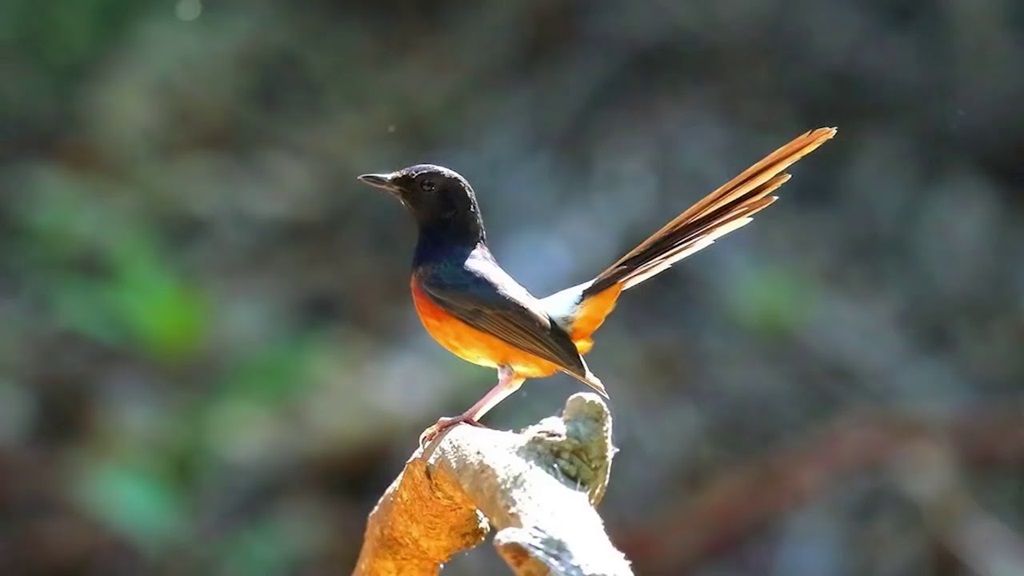
Image of a red-whiskered bulbul standing out in the sunlight.

The red-whiskered bulbul has a chubby, adorable appearance.

A red-whiskered bulbul is showing off its long, beautiful tail.

Image of a red-whiskered bulbul perched on a high tree branch.

A shama with a super long tail.
Through the above article, nicebirds.net has shared detailed information about the Fire Finch such as its origin, habits, techniques to help the bird sing well and how to care for a weakened bird. Hopefully, you have gained a lot of knowledge to be able to successfully raise the most energetic Fire Finch.
If you want to learn more about beautiful birds or other singing birds, please visit our Blog section every day to read the latest articles!

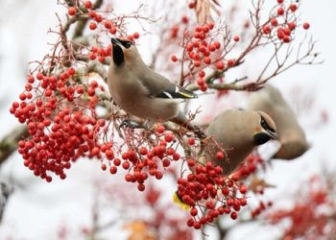

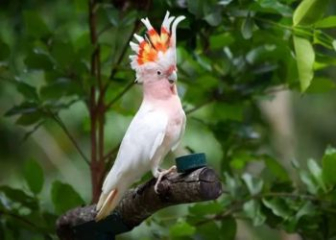
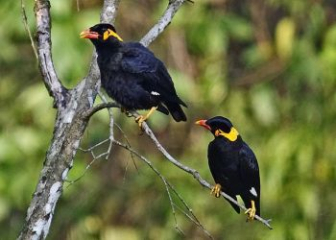
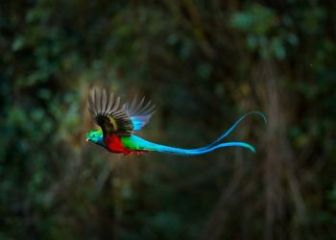





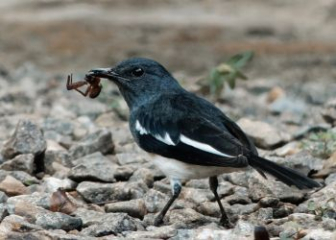
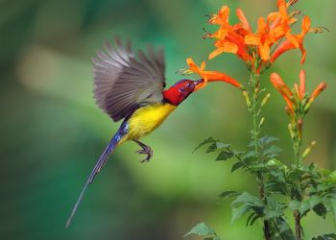


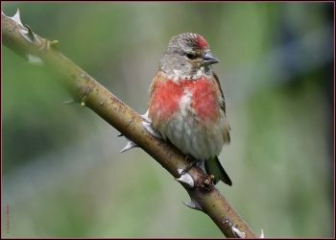
_350x250.jpg)
